October 2, 2018
Carving: “Two Birds” with One Chainsaw!
By Mary Schricker Gemberling
In 2010 when Gary and I had been dating less than a year, his log home burned to the ground leaving nothing but a pile of ashes and a few charred trees. Two of the massive oaks that were closest to the flames were given only a 50/50 chance of survival by a local arborist. This past year, when it was clear that one of them was not going to make it, we decided to have the remaining trunk turned into a piece of art. We had seen wood carvings from time to time at our local and state fairs and in our travels across the world, but that was the extent of our knowledge about the art form.
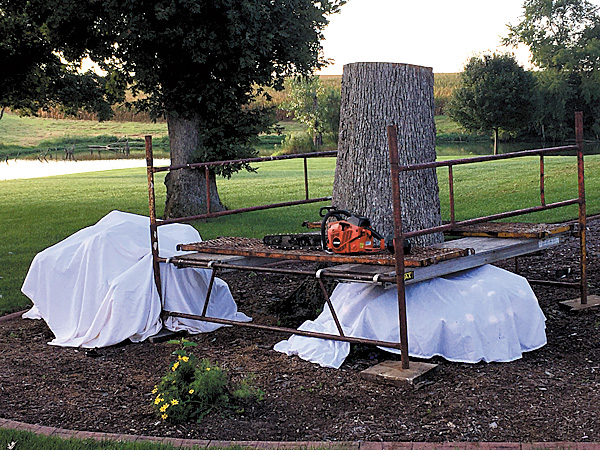
After researching, we found out that wood carving is one of the oldest art forms in the world dating back to prehistoric times when people used wood to make decorative handles for their tools and weapons. In ancient Egypt, religious figures carved of wood were placed in tombs to protect the dead. Wood sculpture in early Christian churches described the life of Christ for worshipers who could not read.
Chainsaw carving was an exciting development in the ancient art of wood carving. For woodcutting purposes, it is thought that a California inventor named R. L. Muir may have been the first to put blades on a chain. The accomplishments of the early chainsaw inventors paved the way for a German mechanical engineer named Andreas Stihl, who is believed to be the inventor of the modern chainsaw. In 1926, he designed the first bucking chainsaw with an electric motor, and in 1929 he patented the first gasoline-driven chainsaw similar to the ones we know today. There are no records of who actually may have created the very first chainsaw carving- only oral histories of what others may have seen or heard. There is really no way of knowing who in what part of the world might have picked up the chainsaw and carved a piece of art for the first time. The oldest chainsaw artist records go back to the 1950’s when Ray Murphy used his father’s chainsaw to carve his name into a piece of wood. In 1961 Ken Kaiser created 50 carvings for the Trees of Mystery, a tourist attraction near the coastal town of Klamath California. In the 1980s the art form really began to grow when the Lumberjack World Championships, held in Hayward Wisconsin, were nationally broadcast. Today chainsaw carving has grown both as a performance art with world-wide competitions, and a visual art supported by various sculpture guilds promoting the
sharing of ideas amongst fellow artisans.
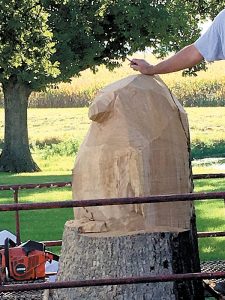 Armed with additional information, Gary and I set out to find the perfect carver to transform our lifeless tree into a work of art. A carver in a nearby town was recommended and a meeting was set up. Sherman Spaid had an extensive portfolio of carvings to show us and seemed to be a good fit for the job. After scrolling through the images on his phone we decided that a “Redbird” would be an appropriate symbol to guard our front yard. Gary is alumni of Illinois State University, where the team mascot is “Reggie Redbird” who is a distant cousin of “Fred bird” from our favorite baseball team the St. Louis Cardinals.
Armed with additional information, Gary and I set out to find the perfect carver to transform our lifeless tree into a work of art. A carver in a nearby town was recommended and a meeting was set up. Sherman Spaid had an extensive portfolio of carvings to show us and seemed to be a good fit for the job. After scrolling through the images on his phone we decided that a “Redbird” would be an appropriate symbol to guard our front yard. Gary is alumni of Illinois State University, where the team mascot is “Reggie Redbird” who is a distant cousin of “Fred bird” from our favorite baseball team the St. Louis Cardinals.
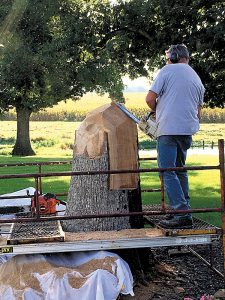 Our next step was to get the tree trimmers to come out and cut the tree down to the desired height for carving. A few weeks later Sherman arrived bright and early at 7 a.m. to begin the project. The first step was to set up scaffolding around the tree both for protection of the plants at the tree’s base and to allow him eye level access for carving. The idea was that the bird would appear to be perched on top of a tree stump about six feet high. As he began to carve away at the bark I could not visualize the end result. I watched with trepidation imagining a hideous chunk of wood sitting in our front yard while Gary and I explained to visitors what it was supposed to be! Not that I didn’t have faith in Sherman’s ability; but this was a new experience for us and what if we didn’t like it? I wasn’t sure we could justify getting rid of it after paying someone this sum of money for a work of art.
Our next step was to get the tree trimmers to come out and cut the tree down to the desired height for carving. A few weeks later Sherman arrived bright and early at 7 a.m. to begin the project. The first step was to set up scaffolding around the tree both for protection of the plants at the tree’s base and to allow him eye level access for carving. The idea was that the bird would appear to be perched on top of a tree stump about six feet high. As he began to carve away at the bark I could not visualize the end result. I watched with trepidation imagining a hideous chunk of wood sitting in our front yard while Gary and I explained to visitors what it was supposed to be! Not that I didn’t have faith in Sherman’s ability; but this was a new experience for us and what if we didn’t like it? I wasn’t sure we could justify getting rid of it after paying someone this sum of money for a work of art.
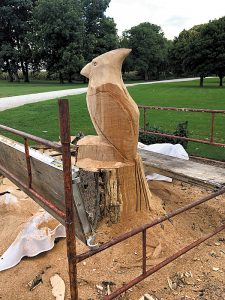
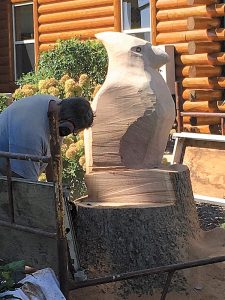 But soon my fears were dissolved as I watched the features of a bird materialize from this raw chunk of wood. The first distinguishable features were the two feet at the base, seemingly necessary for the balance of the somewhat chubby body. Next, the beak and head feathers emerged. I soon breathed a sigh of relief when I saw the slim outline of a bird’s body, similar to the logo on my St. Louis Cardinal clothing.
But soon my fears were dissolved as I watched the features of a bird materialize from this raw chunk of wood. The first distinguishable features were the two feet at the base, seemingly necessary for the balance of the somewhat chubby body. Next, the beak and head feathers emerged. I soon breathed a sigh of relief when I saw the slim outline of a bird’s body, similar to the logo on my St. Louis Cardinal clothing.
Continuing to watch at intervals during the day, I was amazed at how Sherman could wield his chainsaw to transform this chunk of wood with merely an image in his head and without any real pattern. Other wood carving tools were used to carve the tails’ deep grooves as well as the eyes and other finite features. He used a wood burner to darken areas that needed to be shaded. After nearly six hours of carving, “Fred bird” (or “Reggie Redbird” for you Cub fans) was ready for a protective coating to ensure a longer lifespan.
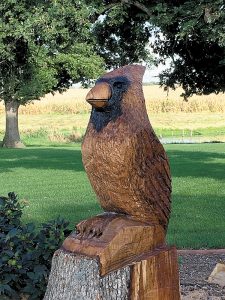 After dusting off the nearby plants and cleaning up the residual sawdust, Gary and I stood back and eyed our newest resident and agreed that Sherman Spaid had far exceeded our expectations. He was a true artist that created a lasting piece of art that we would hopefully enjoy for many years to come. And best of all there would be no need to try to explain to visitors what the image was. The only question we might need to ask first is “Are you a Cub fan or a Cardinal fan?”
After dusting off the nearby plants and cleaning up the residual sawdust, Gary and I stood back and eyed our newest resident and agreed that Sherman Spaid had far exceeded our expectations. He was a true artist that created a lasting piece of art that we would hopefully enjoy for many years to come. And best of all there would be no need to try to explain to visitors what the image was. The only question we might need to ask first is “Are you a Cub fan or a Cardinal fan?”
Mary, a former educator and Seniors Real Estate Specialist, is the author of three books: The West End Kid, Labor of Love; A Personal Journey through the World of Caregiving; Hotel Blackhawk; A Century of Elegance.
Filed Under: Featured, History, Personal Growth
Trackback URL: https://www.50pluslife.com/2018/10/02/carving-two-birds-with-one-chainsaw/trackback/


